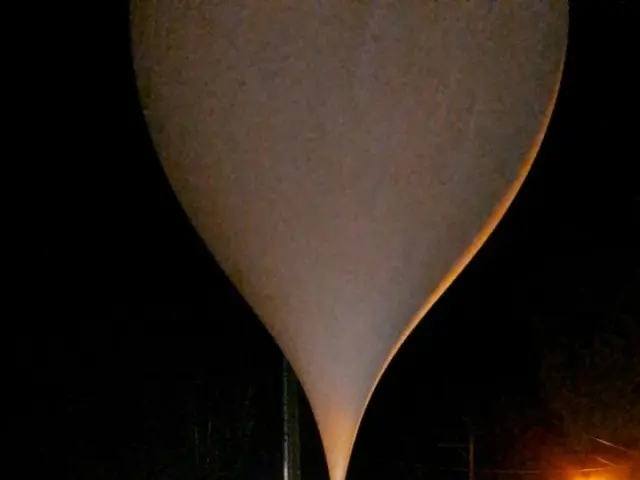As a countermeasure, the government has been sending balloons like these toward South Korea since May. They stopped sending them for nearly a month from the 10th of last month, but they continued to send them for five consecutive days from the 4th of this month.
So far, balloons have caused damage to car windshields and greenhouses in various parts of South Korea, with rubbish hanging from them falling.
A fire believed to have been caused by a "garbage balloon" that had flown into the country broke out in Paju City, Gyeonggi Province, near North Korea. According to South Korean media, the fire began on May 28, when North Korea began releasing "garbage balloons."
By the 10th of last month, the total damage caused by this was estimated to exceed 100 million won (approximately 10.68 million yen) in the metropolitan area alone. In an editorial published on the 10th, the South Korean newspaper Hankyoreh said, "'Garbage balloons' are a big
"It is becoming a part of everyday life in the Republic of Korea," the editorial said. Since North Korea's launch of the "garbage balloons" is seen as a countermeasure against the distribution of anti-North Korea leaflets by defector groups, the editorial pointed out that there is a possibility of North Korea's provocation.
In order to eliminate the spread of North Korean leaflets, the government called on the South Korean government to stop North Korean defector groups from scattering them.
The "North-South Relations Development Act" was enacted, which stops the distribution of leaflets. Human rights groups that have been distributing leaflets are opposed to the law. 27 human rights groups in South Korea have announced that the law stipulates that "distributing leaflets toward North Korea and distributing them to the country is prohibited."
The clause in the law, Article 24, Paragraph 1, Item 3, which states that "no person shall cause harm or serious danger to the life or body of the public" was found to be an "excessive restriction on freedom of expression" and was found to be in violation of the law.
The South Korean Constitutional Court then ruled that the law was unconstitutional in September last year.
The government had been calling for self-restraint, but decided not to do so following the Constitutional Court's ruling. Since then, North Korean defector groups and others have been actively distributing anti-North Korea leaflets again.
In response, North Korea began sending "garbage balloons" toward South Korea in late May. The balloons fell all over South Korea, filling streets with garbage.
In June, the South Korean Ministry of Unification announced the results of an analysis of the contents of the "garbage balloons." Most of the contents were pieces of paper, plastic bottles, and plastic bags, but there were also some Korean-made neckties and jumpers.
The balloons were first released on May 28, six times in June, and three times in July.
The number of balloons released gradually decreased to once a month and once a month last month. They had not been released for nearly a month since the 10th of last month, but were confirmed for five consecutive days from the 4th of this month. It is believed that at least 1,100 balloons were released in the five days.
On the 5th, a garbage balloon fell on the roof of an auto parts manufacturing factory near Gimpo International Airport, causing a fire. On the 8th, a garbage balloon fell on top of a warehouse in Paju, Gyeonggi Province, near North Korea.
A "garbage balloon" fell and caught fire on the roof. A device attached to the balloon and debris were found at the fire at the auto parts manufacturing factory. The South Korean Joint Chiefs of Staff said on the 10th that
"The accident may have occurred in the process of a heating element timer attached to the balloon activating a heat ray to separate the balloon from its payload (garbage)," the agency said.
According to South Korean media, the damage caused by the "garbage balloons" was estimated at 1.2 billion yen on May 28, when North Korea began releasing them.
By the 10th of last month, it was found that the total amounted to 100,528,000 won (approximately 10,733,000 yen) in the metropolitan area alone.
In an editorial on the 10th, the South Korean newspaper Hankyoreh said, "The North Korean
"It has already been 100 days since the 'garbage balloons' began to plague residents in Seoul and the northern part of Gyeonggi Province," he said. He added that North Korea's balloon dropping was a response to the dropping of anti-North Korea leaflets by defector groups.
Considering that this is believed to be a measure being taken, "there has been no proposal from within the (South Korean) government to stop North Korean defectors from scattering leaflets in order to eliminate any room for provocation from North Korea.
The editorial went on to criticize the government's response, saying, "South Korean and U.S. authorities believe that North Korea may take a major step, such as conducting a seventh nuclear test, ahead of the U.S. presidential election in November."
"In this tense and changing situation, isn't it possible that South Korea's pro-North Korea leaflets and North Korea's garbage balloons could become an excuse for an 'accidental clash'? The government should stop being futilely stubborn and start taking measures against North Korea now.
"We should crack down on North Korean leaflets."
2024/09/11 14:06 KST
Copyrights(C)wowkorea.jp 5

